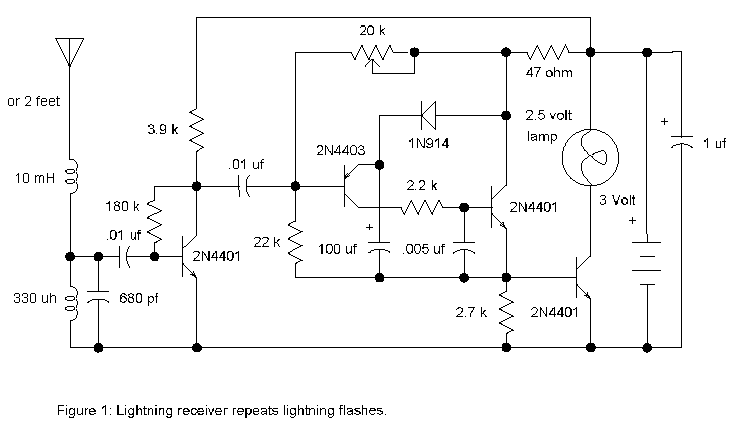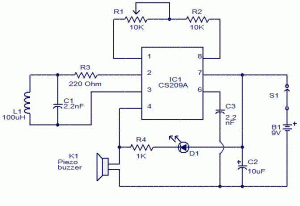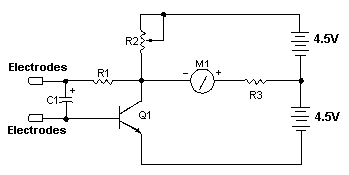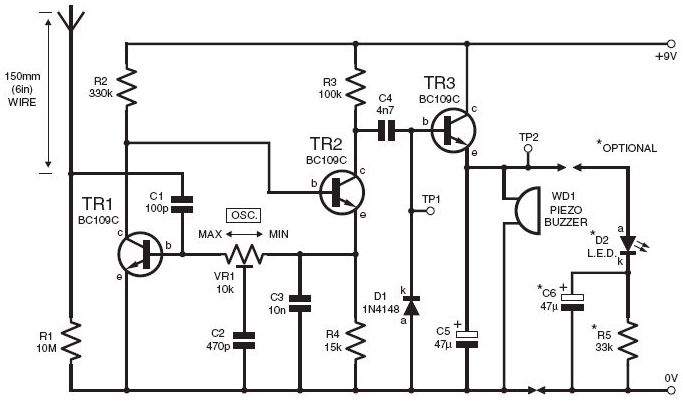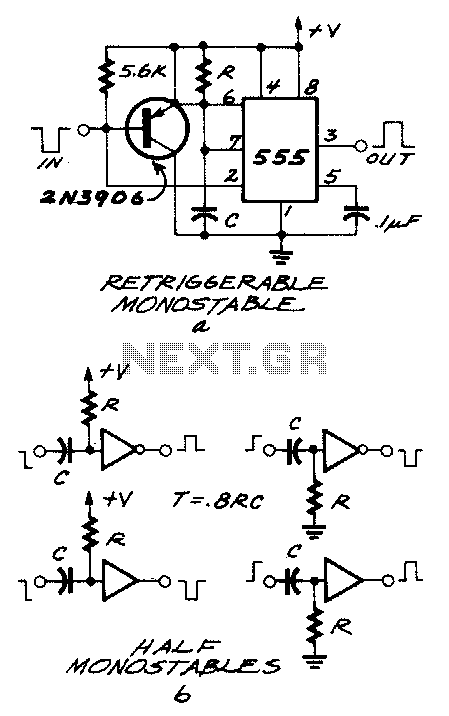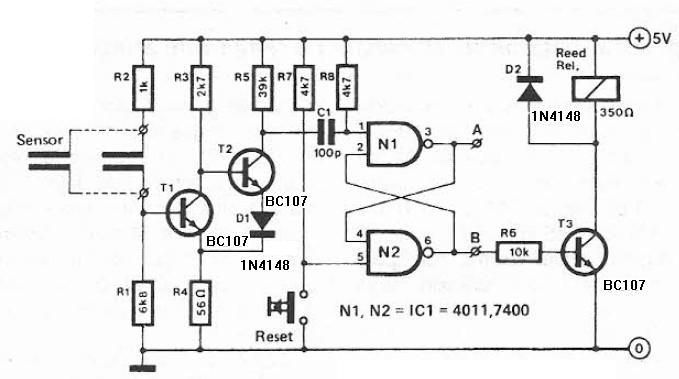
Coupled Coil Metal Detector
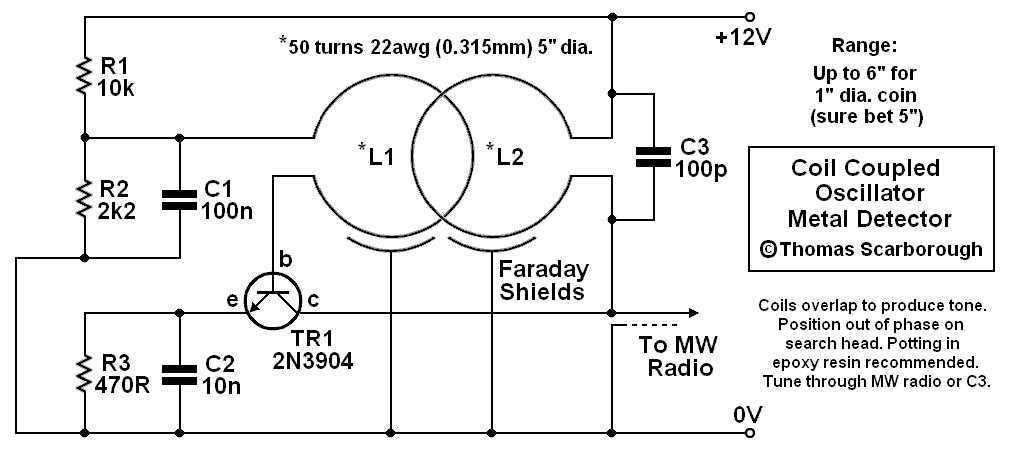
A Coil Coupled Operation Metal Detector made from readily obtainable components and using an ordinary medium receiver as a detector. The metal detector shown here may well represent a new genre. At any rate, after some exposure, it is regarded as such by those who have seen it. It is based on a standard transformer coupled oscillator (TCO) - hence the name Coil Coupled Operation (CCO) Metal Detector. More: Although requiring a BFO (in this case provided by a Medium Wave radio), it differs from a typical BFO detector in that its performance far outstrips that of BFO. Also, unlike BFO, it is dependent on the balance of two coils to boost sensitivity. It also
The Coil Coupled Operation (CCO) Metal Detector utilizes a transformer-coupled oscillator (TCO) design, which is a significant departure from traditional metal detection methods. The core of this device relies on the interaction between two coils, which are strategically balanced to enhance sensitivity to metallic objects. This configuration allows for the detection of metals with greater precision compared to conventional Beat Frequency Oscillator (BFO) detectors.
In this metal detector, a medium wave radio serves as the receiver, providing the necessary BFO signal. The TCO design operates by generating an oscillating magnetic field through the primary coil. When a metallic object enters this field, it induces a secondary oscillation in the secondary coil. The resulting changes in the oscillation frequency are detected by the medium wave radio, which translates these variations into audible signals, indicating the presence of metal.
The choice of components is crucial for the performance of the CCO metal detector. The coils are typically constructed from copper wire, with the number of turns and the diameter of the coils influencing the sensitivity and range of detection. The oscillator circuit may include basic components such as resistors, capacitors, and transistors, which are readily available and cost-effective.
Furthermore, the design allows for adjustments in the coil balance, which can be fine-tuned to optimize sensitivity based on the specific application or type of metal being detected. This feature distinguishes the CCO metal detector from standard BFO detectors, which may not provide the same level of adaptability or performance.
Overall, the CCO metal detector represents an innovative approach to metal detection, combining simplicity in construction with enhanced operational capabilities. It serves as an effective tool for hobbyists and professionals alike in various applications, from treasure hunting to archaeological surveys.A Coil Coupled Operation Metal Detector made from readily obtainable components and using an ordinary medium receiver as a detector. The metal detector shown here may well represent a new genre. At any rate, after some exposure, it is regarded as such by those who have seen it. It is based on a standard transformer coupled oscillator (TCO) - hence the name Coil Coupled Operation (CCO) Metal Detector.
Although requiring a BFO (in this case provided by a Medium Wave radio), it differs from a typical BFO detector in that its performance far outstrips that of BFO. Also, unlike BFO, it is dependent on the balance of two coils to boost sensitivity. It also 🔗 External reference
The Coil Coupled Operation (CCO) Metal Detector utilizes a transformer-coupled oscillator (TCO) design, which is a significant departure from traditional metal detection methods. The core of this device relies on the interaction between two coils, which are strategically balanced to enhance sensitivity to metallic objects. This configuration allows for the detection of metals with greater precision compared to conventional Beat Frequency Oscillator (BFO) detectors.
In this metal detector, a medium wave radio serves as the receiver, providing the necessary BFO signal. The TCO design operates by generating an oscillating magnetic field through the primary coil. When a metallic object enters this field, it induces a secondary oscillation in the secondary coil. The resulting changes in the oscillation frequency are detected by the medium wave radio, which translates these variations into audible signals, indicating the presence of metal.
The choice of components is crucial for the performance of the CCO metal detector. The coils are typically constructed from copper wire, with the number of turns and the diameter of the coils influencing the sensitivity and range of detection. The oscillator circuit may include basic components such as resistors, capacitors, and transistors, which are readily available and cost-effective.
Furthermore, the design allows for adjustments in the coil balance, which can be fine-tuned to optimize sensitivity based on the specific application or type of metal being detected. This feature distinguishes the CCO metal detector from standard BFO detectors, which may not provide the same level of adaptability or performance.
Overall, the CCO metal detector represents an innovative approach to metal detection, combining simplicity in construction with enhanced operational capabilities. It serves as an effective tool for hobbyists and professionals alike in various applications, from treasure hunting to archaeological surveys.A Coil Coupled Operation Metal Detector made from readily obtainable components and using an ordinary medium receiver as a detector. The metal detector shown here may well represent a new genre. At any rate, after some exposure, it is regarded as such by those who have seen it. It is based on a standard transformer coupled oscillator (TCO) - hence the name Coil Coupled Operation (CCO) Metal Detector.
Although requiring a BFO (in this case provided by a Medium Wave radio), it differs from a typical BFO detector in that its performance far outstrips that of BFO. Also, unlike BFO, it is dependent on the balance of two coils to boost sensitivity. It also 🔗 External reference
